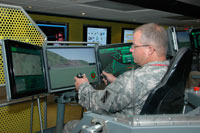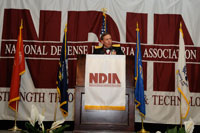The U.S. defense industry—just like the nation as a whole—is facing enormous challenges.
Fighting and prevailing in two major wars is the immediate concern. Over the long term, the greatest threat we face is the financial health of the United States, which could have significant implications for the Defense Department and its supporting industrial base. That may seem odd to outside observers who see a U.S. defense budget that tops $700 billion, and that in 2011 will be the largest since World War II.
Chairman of the Joint Chiefs of Staff Adm. Mike Mullen recently acknowledged that the rapid growth in defense spending that began a decade ago, after the 9/11 terrorist attacks, is not sustainable. The reason is obvious. The nation’s debt is spiraling out of control. The $3.8 trillion federal budget in 2011 projects huge deficits—the lowest being $700 billion in 2013 — well into the future, long after the present recession is predicted to end. By 2019, the interest on the debt is estimated to be around $800 billion—much larger than the defense budget.
It is quite clear that these alarming trends will affect defense budgets sooner than imagined. In the immediate future, the task at hand for the U.S. industrial base is to be able to meet the needs of the nation’s forces for world-class weapons systems. The U.S. advantage on the battlefield is based on three factors: the quality of its recruits, the quality of its systems and the quality of its training.
Preserving Crucial Skills Properly viewed, the defense industrial base has only one customer: the government. If the government doesn’t buy, the base will become extinct. Only a few firms have commercial work, and much of that commercial work is not transferrable to defense products.
Properly viewed, the defense industrial base has only one customer: the government. If the government doesn’t buy, the base will become extinct. Only a few firms have commercial work, and much of that commercial work is not transferrable to defense products.
When defense budgets do start heading downward, the Defense Department will have to be concerned about preserving critical capabilities so that crucial skills don’t vanish during lean times. Once a program is shuttered, design teams—both for systems and manufacturing—tend to transition to other industries or just fade away. To restart or duplicate programs (such as advanced ground vehicles or ships), is not possible in the short run. That is the reason why it’s important to have in production some version of a specific class of weapon.
Another requisite is competition. When the U.S. industrial capability began to ramp up in World War II, the nation had the luxury of many suppliers that competed for contracts. The reduced demand resulting from the collapse of the Soviet Union led to the fateful “last supper” with Defense Secretary William Perry, when the Pentagon directed the downsizing and consolidation of the U.S. industrial base. That contraction has continued to this day to where we now have only one supplier for some major systems and numerous single sources (some overseas) for commodities. As competition is reduced, cost and quality suffer.
Requirements for a Healthy Industrial Base
The two basic requirements for a healthy industrial base—ongoing programs and a competitive environment—can be achieved in a number of ways.
One option might be to support prototype competitions for important capabilities. The prototypes might never enter production, but they would serve to continue technology development and maintain design team expertise.
A significant concern for the industrial base is the need to make the international trade regime more open for U.S. exports. The National Defense Industrial Association (NDIA) has worked extensively on this issue. There has been some limited improvement in the International Traffic in Arms Regulations, but much more needs to be done.
U.S. industry depends upon exports for its financial health and to maintain proficiency. Some areas of the industrial base, especially the space sector, are suffering. Regulations in this sector are so restrictive that U.S. industry is losing business to overseas competitors. One now routinely sees advertisements of “ITAR-Free” products in the space sector. This reflects the unreasonable restrictions the space industrial sector suffers.
Skilled Workforce
Another key issue is the need to ensure there is enough funding to sustain a skilled workforce.
The looming crisis in the nation’s ability to sustain its technical expertise has been widely publicized. Many seasoned engineers and scientists will be retiring in the next several years. Recruiting fresh talent will prove to be the biggest near-term objective. The challenge is not just to bring in bodies, but bodies with the right skills. Qualifications need to include a higher percentage of professionals with scientific, mathematic and engineering backgrounds. Contracting and program management personnel must come equipped with the requisite technical know-how to evaluate the merits of alternative technical solutions. Their pay needs to be comparable with private industry to attract and retain these highly trained personnel.
The most important issue ultimately is technical expertise. The United States is not producing enough graduates trained in science, technology engineering and mathematics (STEM) who qualify for security clearances.
It is necessary to excite and prepare greater numbers of students who are motivated to enter vocational, undergraduate and graduate programs in STEM. With industry, government and community involvement, this can be achieved. But it will take coordinated, sustained focus on improving the educational system beginning in middle school.
Manufacturing
Along with worries about the loss of technical expertise, there is also considerable apprehension in the defense industry about the nation’s declining manufacturing capabilities. Manufacturing has enormous impact across all aspects of the U.S. economy and national security. It represents almost 14 percent of the U.S. gross domestic product.
The nation’s economic health, competitiveness, and the strength of its military rely heavily on innovation and leading edge technology. This requires a globally competitive manufacturing industrial base that is characterized by leadership in advanced manufacturing and technology integration.
The defense sector, which years ago was a technology leader, is now in many instances a follower and relies almost entirely on commercial products for its advanced components and systems.
We live in a world that has become more global and much more competitive. Past practices that made the nation number one in manufacturing innovation and output will not guarantee success in the future.
Energy Security Last but not least on the agenda for the defense industry is the issue of energy security. The need to wean the military from its dependence on oil is critical. When it comes to military energy priorities, we must get beyond the traditional cost-benefit analysis that inevitably is tied to the price of oil.
Last but not least on the agenda for the defense industry is the issue of energy security. The need to wean the military from its dependence on oil is critical. When it comes to military energy priorities, we must get beyond the traditional cost-benefit analysis that inevitably is tied to the price of oil.
In the coming years, the goal is to introduce more energy-efficient tactical vehicles (such as hybrid-electric trucks), and to seek other ways to lower the consumption of fossil fuels. For the military, diversifying energy sources is more than just about cost savings. Seventy percent of the convoys in Iraq and Afghanistan transport just fuel and water. These convoys are at risk from roadside bombs and snipers. Just moving fuel entails great danger to U.S. troops, and the cost of protecting those convoys keeps rising. If we could cut the amount of these convoys in half, the logistics tail also would be significantly reduced.
Another consequence of burning less oil is that national security is strengthened. A decline in petroleum demand would allow the U.S. to place less reliance on countries that are not friendly. This would help lower pressures on the military to remain engaged internationally. It also would contribute to stabilizing the conditions for doing business in bad neighborhoods around the world. This lowered burden translates into more efficient use of national resources—military and others. As we import less, we spend less and lower our budget and balance of payments deficit.
Solving these Problems
In summary, there is no shortage of challenges for our industry and for the nation, not just in the realm of defense and security, but also in getting our fiscal house in order. Solving these problems will require leaders in industry and government to partner, make tough decisions and plan smartly for the future—that is the core element of NDIA’s mission.
For information on NDIA events and activities, go to http://www.NDIA.org/MEETINGS.

